Direct Regeneration of Degraded LiFePO4 Cathode via Reductive Solution Relithiation Regeneration Process
Abstract
:1. Introduction
2. Results and Discussion
2.1. Structural and Morphology Characterization
2.2. Electrochemical Performance
3. Experimental Section
3.1. Pretreatment of Materials
3.2. Direct Regeneration of D-LFP
3.3. Material Characterization
3.4. Electrochemical Measurements
4. Conclusions
Supplementary Materials
Author Contributions
Funding
Institutional Review Board Statement
Informed Consent Statement
Data Availability Statement
Conflicts of Interest
References
- Ma, X.; Azhari, L.; Wang, Y. Li-ion battery recycling challenges. Chem 2021, 7, 2843–2847. [Google Scholar] [CrossRef]
- Harper, G.; Sommerville, R.; Kendrick, E.; Driscoll, L.; Slater, P.; Stolkin, R.; Walton, A.; Christensen, P.; Heidrich, O.; Lambert, S.; et al. Recycling lithium-ion batteries from electric vehicles. Nature 2019, 575, 75–86. [Google Scholar] [CrossRef] [PubMed]
- Choux, M.; Pripp, S.W.; Kvalnes, F.; Hellström, M. To shred or to disassemble—A techno-economic assessment of automated disassembly vs. shredding in lithium-ion battery module recycling. Resour. Conserv. Recycl. 2024, 203, 107430. [Google Scholar] [CrossRef]
- Yao, X.; Li, D.; Guo, L.; Kallel, M.; Alahmari, S.D.; Ren, J.; Seok, I.; Roymahapatra, G.; Wang, C. Carbon-coated LiMn0.8Fe0.2PO4 cathodes for high-rate lithium-ion batteries. Adv. Compos. Hybrid Mater. 2024, 7, 63. [Google Scholar] [CrossRef]
- Xu, Y.; Zhang, B.; Ge, Z.; Zhang, S.; Song, B.; Tian, Y.; Deng, W.; Zou, G.; Hou, H.; Ji, X. Advances and perspectives towards spent LiFePO4 battery recycling. J. Clean. Prod. 2024, 434, 140077. [Google Scholar] [CrossRef]
- Du, M.; Guo, J.-Z.; Zheng, S.-H.; Liu, Y.; Yang, J.-L.; Zhang, K.-Y.; Gu, Z.-Y.; Wang, X.-T.; Wu, X.-L. Direct reuse of LiFePO4 cathode materials from spent lithium-ion batteries: Extracting Li from brine. Chin. Chem. Lett. 2023, 34, 107706. [Google Scholar] [CrossRef]
- Yang, Y.; Zhang, J.; Zhang, H.; Wang, Y.; Chen, Y.; Wang, C. Simultaneous anodic de-lithiation/cathodic lithium-embedded regeneration method for recycling of spent LiFePO4 battery. Energy Storage Mater. 2024, 65, 103081. [Google Scholar] [CrossRef]
- Yu, F.; Xu, X.; Guo, Y. Recovery of metal ions in lithium iron phosphate powder and lithium nickel-cobalt-manganate powder by electrochemical oxidation. Sep. Purif. Technol. 2024, 344, 127134. [Google Scholar] [CrossRef]
- Xu, Y.; Qiu, X.; Zhang, B.; Di, A.; Deng, W.; Zou, G.; Hou, H.; Ji, X. Start from the source: Direct treatment of a degraded LiFePO4 cathode for efficient recycling of spent lithium-ion batteries. Green Chem. 2022, 24, 7448–7457. [Google Scholar] [CrossRef]
- Fan, M.-C.; Wozny, J.; Gong, J.; Kang, Y.-Q.; Wang, X.-S.; Zhang, Z.-X.; Zhou, G.-M.; Zhao, Y.; Li, B.-H.; Kang, F.-Y. Lithium metal recycling from spent lithium-ion batteries by cathode overcharging process. Rare Met. 2022, 41, 1843–1850. [Google Scholar] [CrossRef]
- Biswal, B.K.; Zhang, B.; Thi Minh Tran, P.; Zhang, J.; Balasubramanian, R. Recycling of spent lithium-ion batteries for a sustainable future: Recent advancements. Chem. Soc. Rev. 2024, 53, 5552–5592. [Google Scholar] [CrossRef]
- Carreira, E.M. A look back at 2022 and forward to 2023. J. Am. Chem. Soc. 2023, 145, 3255–3256. [Google Scholar] [CrossRef]
- Yan, T.; Zhong, S.; Zhou, M.; Guo, X.; Hu, J.; Wang, F.; Zeng, F.; Zuo, S. High-efficiency method for recycling lithium from spent LiFePO4 cathode. Nanotechnol. Rev. 2020, 9, 1586–1593. [Google Scholar] [CrossRef]
- Fu, D.; Zhou, W.; Liu, J.; Zeng, S.; Wang, L.; Liu, W.; Yu, X.; Liu, X. A facile route for the efficient leaching, recovery, and regeneration of lithium and iron from waste lithium iron phosphate cathode materials. Sep. Purif. Technol. 2024, 342, 127069. [Google Scholar] [CrossRef]
- Fu, Y.; Schuster, J.; Petranikova, M.; Ebin, B.J.R. Innovative recycling of organic binders from electric vehicle lithium-ion batteries by supercritical carbon dioxide extraction. Conserv. Recycl. 2021, 172, 105666. [Google Scholar] [CrossRef]
- Raj, T.; Chandrasekhar, K.; Kumar, A.N.; Sharma, P.; Pandey, A.; Jang, M.; Jeon, B.H.; Varjani, S.; Kim, S.H. Recycling of cathode material from spent lithium-ion batteries: Challenges and future perspectives. J. Hazard. Mater. 2022, 429, 128312. [Google Scholar] [CrossRef] [PubMed]
- Kumar, J.; Neiber, R.R.; Park, J. Recent progress in sustainable recycling of LiFePO4-type lithium-ion batteries: Strategies for highly selective lithium recovery. Chem. Eng. J. 2022, 431, 133993. [Google Scholar] [CrossRef]
- Dai, Y.; Xu, Z.; Hua, D.; Gu, H.; Wang, N. Theoretical-molar Fe3+ recovering lithium from spent LiFePO4 batteries: An acid-free, efficient, and selective process. J. Hazard. Mater. 2020, 396, 122707. [Google Scholar] [CrossRef]
- Rohr, S.; Wagner, S.; Baumann, M.; Muller, S.; Lienkamp, M. A techno-economic analysis of end of life value chains for lithium-ion batteries from electric vehicles. In Proceedings of the 2017 Twelfth International Conference on Ecological Vehicles and Renewable Energies (EVER), Monte-Carlo, Monaco, 11–13 April 2017; IEEE: Piscataway, NJ, USA, 2017. [Google Scholar]
- Roy, J.J.; Cao, B.; Madhavi, S.J.C. A review on the recycling of spent lithium-ion batteries (LIBs) by the bioleaching approach. Chemosphere 2021, 282, 130944. [Google Scholar] [CrossRef]
- Li, Z.; Liu, D.; Xiong, J.; He, L.; Zhao, Z.; Wang, D. Selective recovery of lithium and iron phosphate/carbon from spent lithium iron phosphate cathode material by anionic membrane slurry electrolysis. Waste Manag. 2020, 107, 1–8. [Google Scholar] [CrossRef]
- Chen, B.; Liu, M.; Cao, S.; Hu, H.; Chen, G.; Guo, X.; Wang, X. Direct regeneration and performance of spent LiFePO4 via a green efficient hydrothermal technique. J. Alloys Compd. 2022, 924, 166487. [Google Scholar] [CrossRef]
- Ouaneche, T.; Courty, M.; Stievano, L.; Monconduit, L.; Guéry, C.; Sougrati, M.T.; Recham, N. Room temperature efficient regeneration of spent LiFePO4 by direct chemical lithiation. J. Power Sources 2023, 579, 233248. [Google Scholar] [CrossRef]
- Zhang, L.; Xu, Z.; He, Z. Electrochemical Relithiation for Direct Regeneration of LiCoO2 Materials from Spent Lithium-Ion Battery Electrodes. ACS Sustain. Chem. Eng. 2020, 8, 11596–11605. [Google Scholar] [CrossRef]
- Qin, Z.; Li, X.; Shen, X.; Cheng, Y.; Wu, F.; Li, Y.; He, Z. Electrochemical selective lithium extraction and regeneration of spent lithium iron phosphate. Waste Manag. 2024, 174, 106–113. [Google Scholar] [CrossRef] [PubMed]
- Zhang, J.; Zou, J.; He, D.; Hu, W.; Peng, D.; Li, Y.; Zhao, Z.; Wang, S.; Li, P.; Su, S. Molten salt infiltration–oxidation synergistic controlled lithium extraction from spent lithium iron phosphate batteries: An efficient, acid free, and closed-loop strategy. Green Chem. 2023, 25, 6057–6066. [Google Scholar] [CrossRef]
- Zhang, B.; Xu, Y.; Silvester, D.S.; Banks, C.E.; Deng, W.; Zou, G.; Hou, H.; Ji, X. Direct regeneration of cathode materials in spent lithium-ion batteries toward closed-loop recycling and sustainability. J. Power Sources 2024, 589, 233728. [Google Scholar] [CrossRef]
- Zheng, R.; Zhao, L.; Wang, W.; Liu, Y.; Ma, Q.; Mu, D.; Li, R.; Dai, C. Optimized Li and Fe recovery from spent lithium-ion batteries via a solution-precipitation method. RSC Adv. 2016, 49, 43613–43625. [Google Scholar] [CrossRef]
- Roldán-Ruiz, M.J.; Ferrer, M.L.; Gutiérrez, M.C.; del Monte, F. Highly efficient p-toluenesulfonic acid-based deep-eutectic solvents for cathode recycling of Li-ion batteries. ACS Sustain. Chem. Eng. 2020, 8, 5437–5445. [Google Scholar] [CrossRef]
- Peeters, N.; Binnemans, K.; Riaño, S. Solvometallurgical recovery of cobalt from lithium-ion battery cathode materials using deep-eutectic solvents. Green Chem. 2020, 22, 4210–4221. [Google Scholar] [CrossRef]
- Fei, Z.; Zhang, Y.; Meng, Q.; Dong, P.; Li, Y.; Fei, J.; Qi, H.; Yan, J. The auto-oxidative relithiation of spent cathode materials at low temperature environment for efficient and sustainable regeneration. J. Hazard. Mater. 2022, 432, 128664. [Google Scholar] [CrossRef]
- Tang, D.; Ji, G.; Wang, J.; Liang, Z.; Chen, W.; Ji, H.; Ma, J.; Liu, S.; Zhuang, Z.; Zhou, G. A Multifunctional Amino Acid Enables Direct Recycling of Spent LiFePO4 Cathode Material. Adv. Mater. 2024, 36, e2309722. [Google Scholar] [CrossRef] [PubMed]
- Ding, Y.; Fu, J.; Zhang, S.; He, X.; Zhao, B.; Ren, J.; Zhong, J.; Liu, Z. Advances in recycling LiFePO4 from spent lithium batteries: A critical review. Sep. Purif. Technol. 2024, 338, 126551. [Google Scholar] [CrossRef]
- Gou, Y.; Qi, C.; Li, R.; Liu, X.; Zhou, Z.; Zhang, M.; Sun, Q.; Song, L.; Jin, Y. Direct regeneration of high-value LiFePO4 cathode materials with nitrogen doped carbon coating. Electrochim. Acta 2024, 488, 144180. [Google Scholar] [CrossRef]
- Yin, C.; Pan, C.; Pan, Y.; Hu, J. Hierarchical spheroidal MOF-derived MnO@C as cathode components for high-performance aqueous zinc ion batteries. J. Colloid. Interface Sci. 2023, 642, 513–522. [Google Scholar] [CrossRef] [PubMed]
- Teng, J.; Tang, X.; Tang, M.; Wu, Q.; Li, J. Failure mechanism and voltage regulation strategy of low N/P ratio lithium iron phosphate battery. J. Energy Storage 2022, 51, 104588. [Google Scholar] [CrossRef]
- Yang, J.; Zhou, K.; Gong, R.; Meng, Q.; Zhang, Y.; Dong, P. Direct regeneration of spent LiFePO4 materials via a green and economical one-step hydrothermal process. J. Environ. Manag. 2023, 348, 119384. [Google Scholar] [CrossRef] [PubMed]
- Yin, C.; Pan, C.; Pan, Y.; Hu, J.; Fang, G. Proton Self-Doped Polyaniline with High Electrochemical Activity for Aqueous Zinc-Ion Batteries. Small Methods 2023, 7, 2300574. [Google Scholar] [CrossRef]
- Liu, K.; Wang, J.; Wang, M.; Zhang, Q.; Cao, Y.; Huang, L.; Valix, M.; Tsang, D.C.W. Low-carbon recycling of spent lithium iron phosphate batteries via a hydro-oxygen repair route. Green. Chem. 2023, 25, 6642–6651. [Google Scholar] [CrossRef]
- Yang, Y.; Chen, L.; Yang, L.; Du, X.; Yang, Y. Capacity fade characteristics of lithium iron phosphate cell during dynamic cycle. Energy 2020, 206, 118155. [Google Scholar] [CrossRef]
- Lei, S.; Sun, W.; Yang, Y. Comprehensive Technology for Recycling and Regenerating Materials from Spent Lithium Iron Phosphate Battery. Environ. Sci. Technol. 2024, 58, 3609–3628. [Google Scholar] [CrossRef]
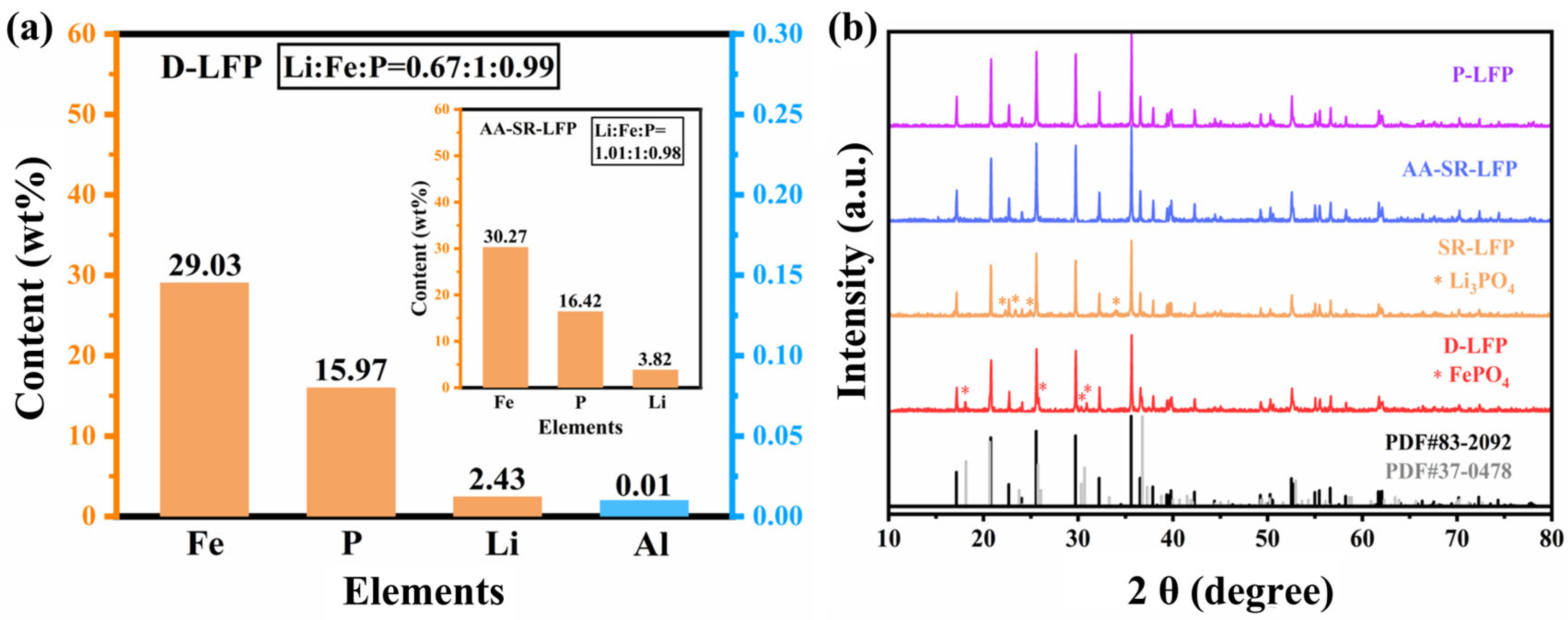
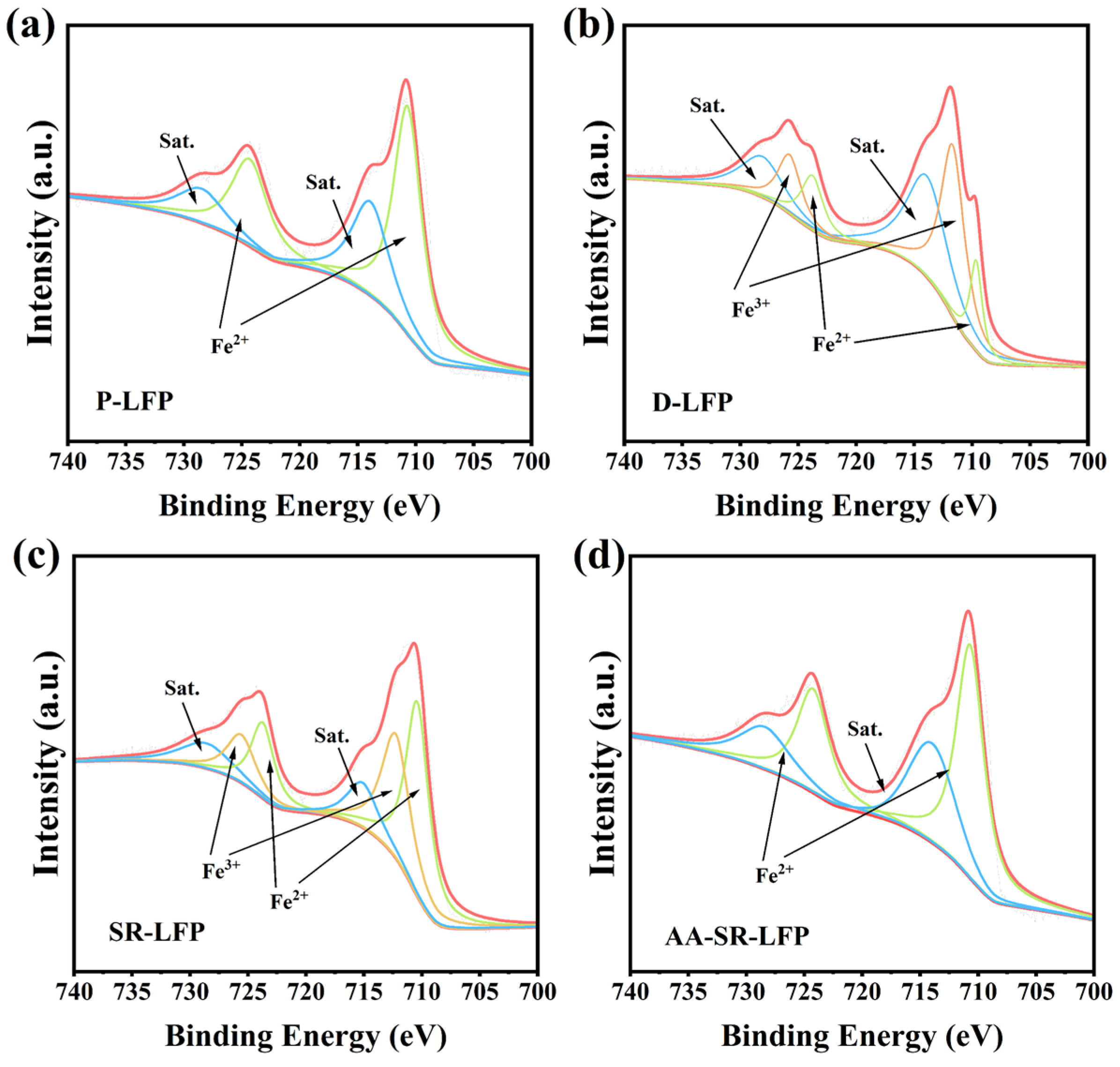
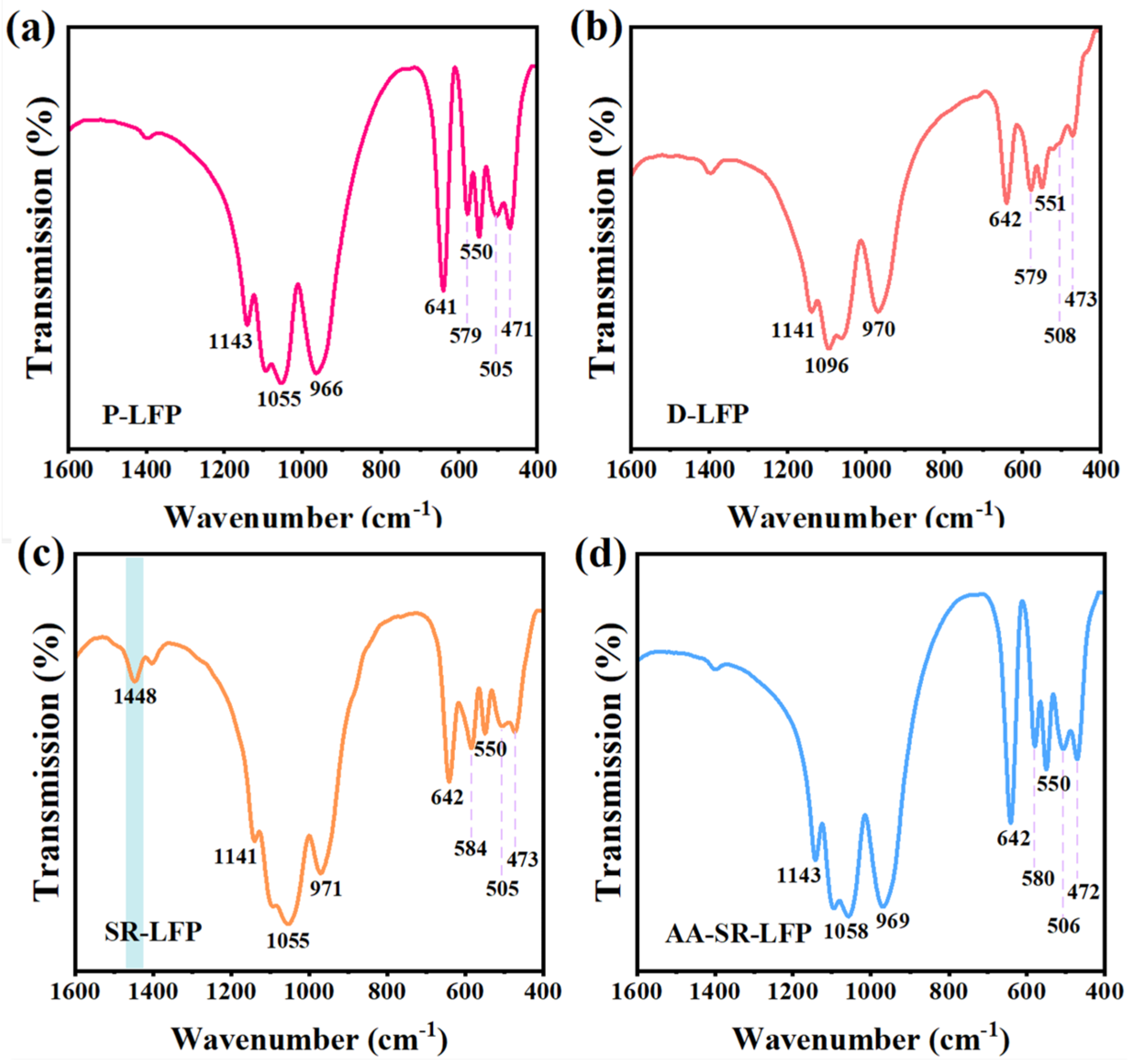
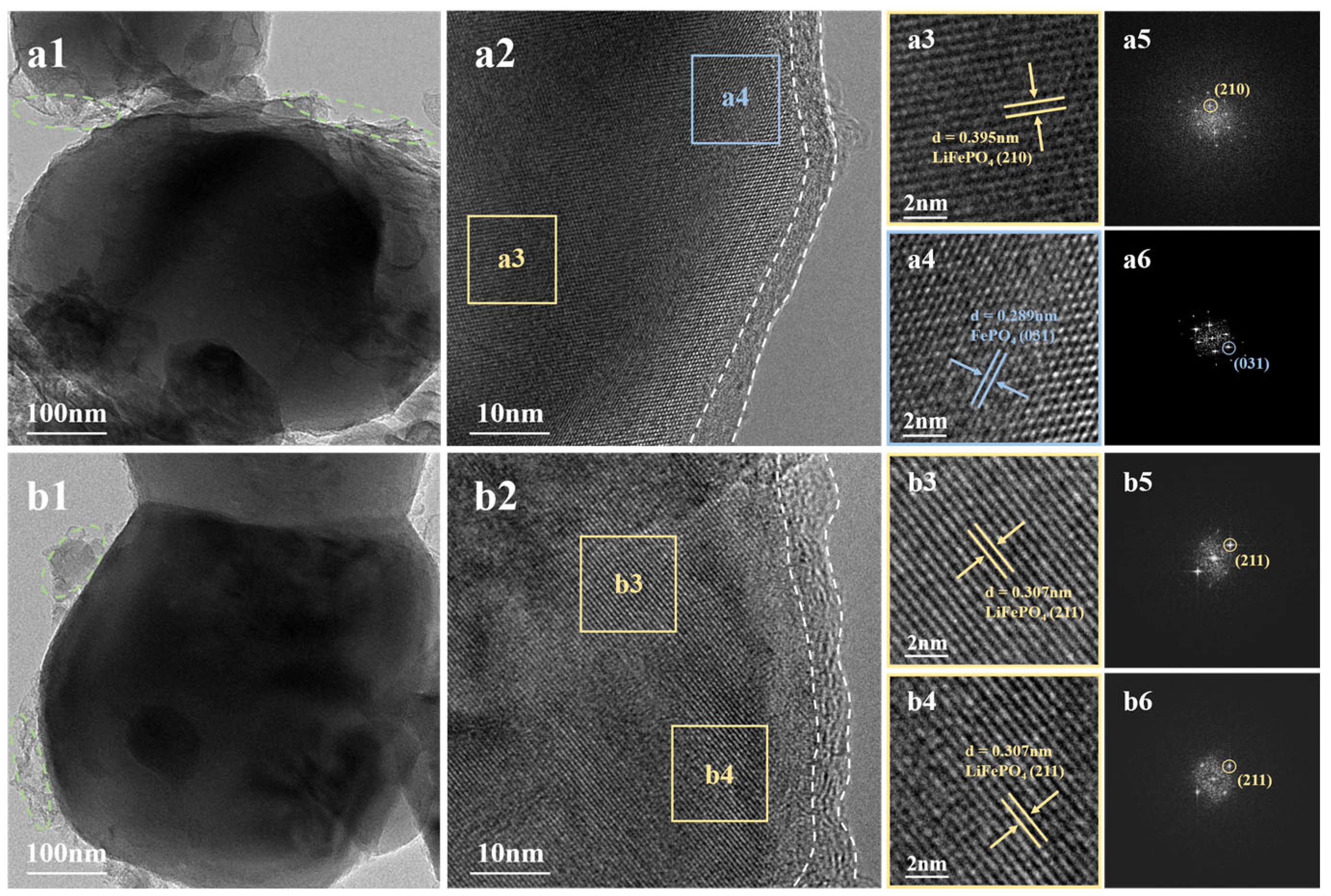
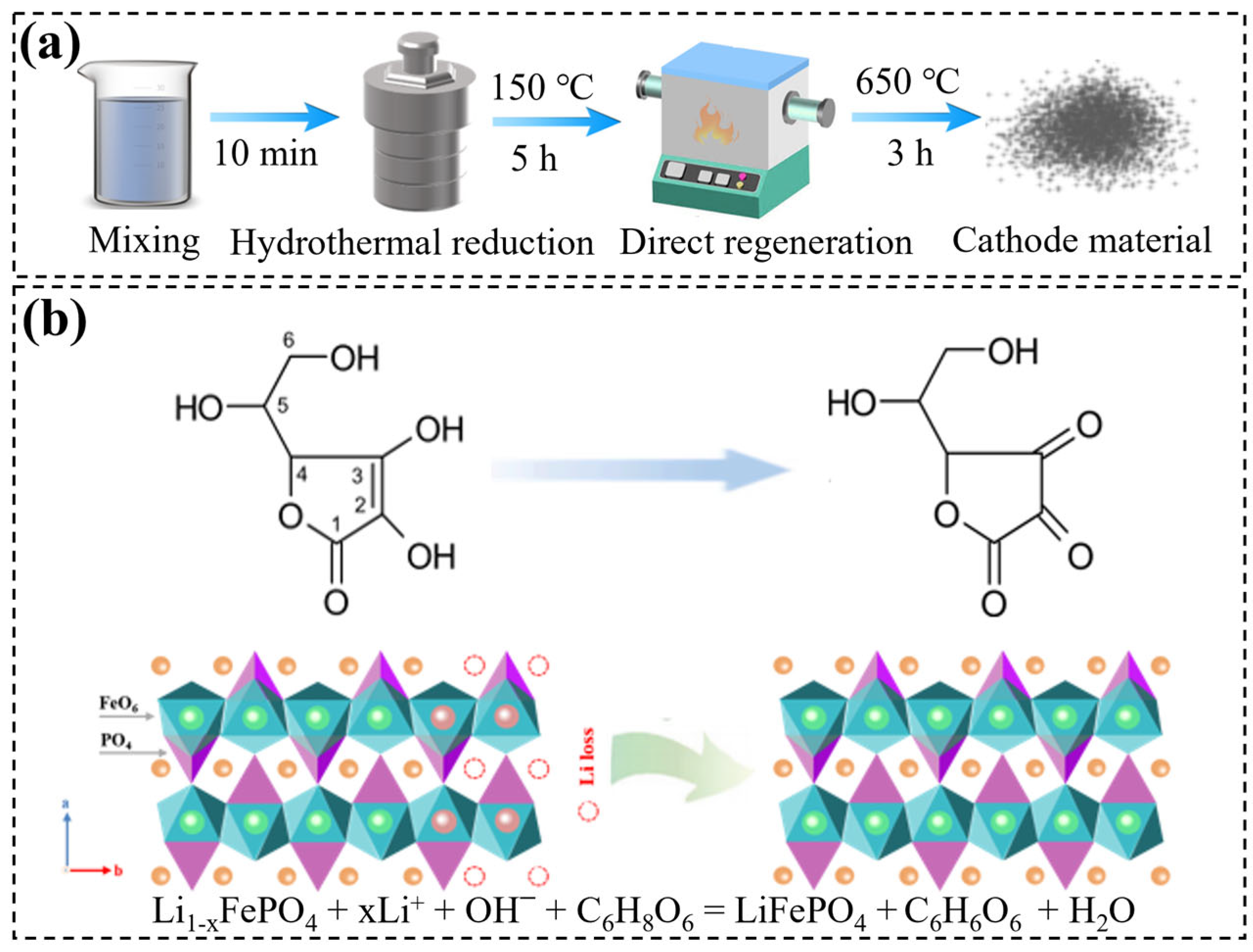


Disclaimer/Publisher’s Note: The statements, opinions and data contained in all publications are solely those of the individual author(s) and contributor(s) and not of MDPI and/or the editor(s). MDPI and/or the editor(s) disclaim responsibility for any injury to people or property resulting from any ideas, methods, instructions or products referred to in the content. |
© 2024 by the authors. Licensee MDPI, Basel, Switzerland. This article is an open access article distributed under the terms and conditions of the Creative Commons Attribution (CC BY) license (https://creativecommons.org/licenses/by/4.0/).
Share and Cite
Li, C.; Gong, R.; Zhang, Y.; Meng, Q.; Dong, P. Direct Regeneration of Degraded LiFePO4 Cathode via Reductive Solution Relithiation Regeneration Process. Molecules 2024, 29, 3340. https://doi.org/10.3390/molecules29143340
Li C, Gong R, Zhang Y, Meng Q, Dong P. Direct Regeneration of Degraded LiFePO4 Cathode via Reductive Solution Relithiation Regeneration Process. Molecules. 2024; 29(14):3340. https://doi.org/10.3390/molecules29143340
Chicago/Turabian StyleLi, Chenchen, Rui Gong, Yingjie Zhang, Qi Meng, and Peng Dong. 2024. "Direct Regeneration of Degraded LiFePO4 Cathode via Reductive Solution Relithiation Regeneration Process" Molecules 29, no. 14: 3340. https://doi.org/10.3390/molecules29143340
APA StyleLi, C., Gong, R., Zhang, Y., Meng, Q., & Dong, P. (2024). Direct Regeneration of Degraded LiFePO4 Cathode via Reductive Solution Relithiation Regeneration Process. Molecules, 29(14), 3340. https://doi.org/10.3390/molecules29143340




